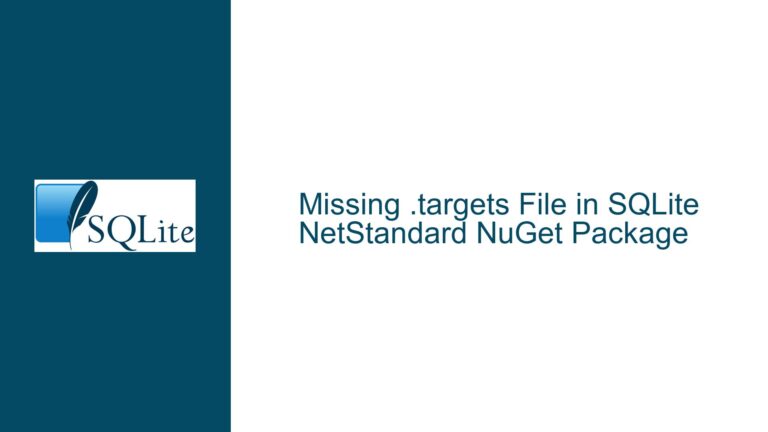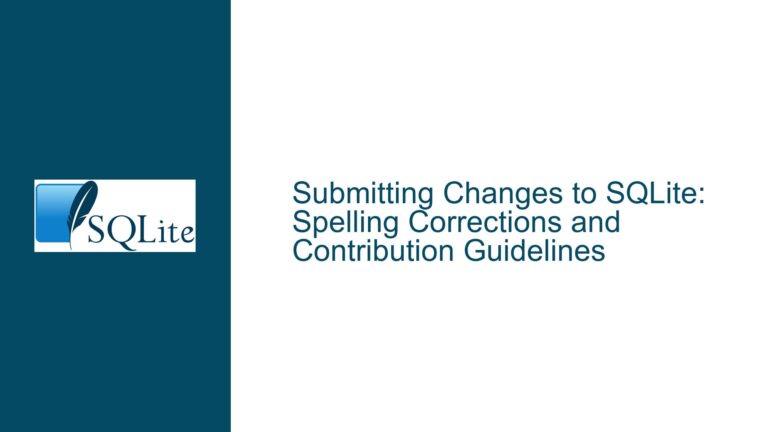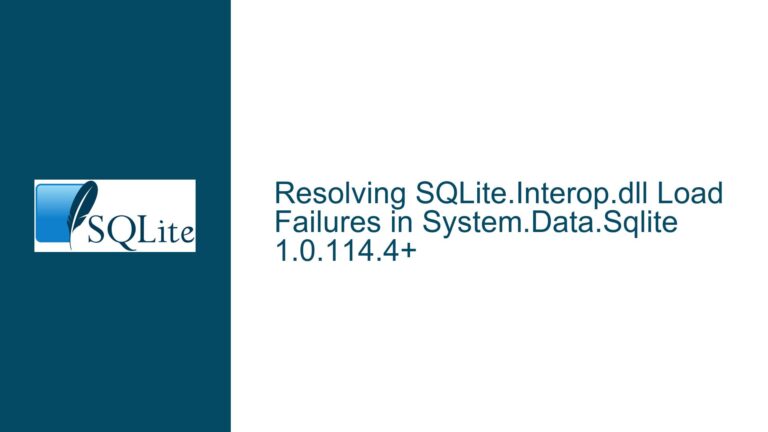Validating URI Parameter Names in SQLite VFS: Ensuring Correct Parameter Usage
Understanding URI Parameter Validation in SQLite VFS
When working with SQLite’s Virtual File System (VFS), one of the critical tasks is ensuring that the URI parameter names passed to the VFS are valid and recognized by the SQLite core. URI parameters are used to configure various aspects of the database connection, such as enabling or disabling certain features, setting cache sizes, or controlling locking behavior. However, if a parameter name is misspelled or unrecognized, it can lead to unintended behavior, such as the parameter being silently ignored, which may cause issues that are difficult to diagnose.
The core issue revolves around how to validate these URI parameter names at runtime. Specifically, the challenge is to distinguish between parameter names that are recognized by the SQLite core and those that are invalid due to typos or other errors. The goal is to fail early and explicitly when an invalid parameter name is encountered, rather than allowing the parameter to be ignored, which could lead to subtle bugs or misconfigurations.
SQLite provides a set of documented URI parameter names, such as nolock, which are recognized by the core. However, the question arises: how can a VFS implementation determine at runtime whether a given parameter name is valid or invalid? This is particularly important for custom VFS implementations or when extending SQLite with additional parameters that may not be part of the standard documentation.
Possible Causes of Unrecognized URI Parameter Names
There are several reasons why a URI parameter name might not be recognized by the SQLite core or the VFS implementation. One common cause is a simple typo or misspelling in the parameter name. For example, if a user intends to use the nolock parameter but mistakenly types nolok, the parameter will not be recognized, and the intended behavior (disabling locking) will not be applied. This can lead to unexpected behavior, especially in multi-threaded or multi-process environments where locking is critical for data integrity.
Another possible cause is the use of custom or non-standard parameter names that are not part of the SQLite core’s documented set. In some cases, developers may extend SQLite by adding custom parameters to the VFS or other components. If these custom parameters are not properly documented or integrated into the SQLite core, they may not be recognized, leading to similar issues as with misspelled parameter names.
Additionally, the SQLite core itself may evolve over time, with new parameters being added or existing parameters being deprecated. If a VFS implementation is not updated to reflect these changes, it may fail to recognize valid parameter names, leading to compatibility issues. This is particularly relevant when using older VFS implementations with newer versions of SQLite, or vice versa.
Finally, there may be cases where the parameter name is valid, but the VFS implementation does not support it. For example, a parameter might be recognized by the SQLite core but not implemented in a particular VFS. In such cases, the parameter may be silently ignored, leading to unexpected behavior. This highlights the importance of ensuring that the VFS implementation is fully aware of the parameters it supports and can validate them appropriately.
Troubleshooting Steps, Solutions & Fixes for URI Parameter Validation
To address the issue of validating URI parameter names in SQLite VFS, several steps can be taken to ensure that parameter names are correctly recognized and handled. The following are detailed troubleshooting steps, solutions, and fixes that can be applied to resolve this issue:
1. Implementing Parameter Validation in the VFS:
The first step in ensuring that URI parameter names are correctly validated is to implement a mechanism within the VFS to check whether a given parameter name is recognized. This can be done by maintaining a list of valid parameter names within the VFS implementation. When a URI is passed to the VFS, the implementation can iterate through the list of valid parameter names and compare them to the parameter names in the URI. If a parameter name is not found in the list, the VFS can raise an error or log a warning, indicating that the parameter is unrecognized.
This approach requires that the VFS implementation be aware of all the parameter names that it supports, as well as those recognized by the SQLite core. This list should be kept up-to-date with any changes in the SQLite core or the VFS implementation itself. Additionally, the VFS should be designed to handle cases where new parameters are added or existing parameters are deprecated, ensuring that the validation mechanism remains accurate over time.
2. Leveraging SQLite Core’s Parameter Recognition:
Another approach is to leverage the SQLite core’s own mechanisms for recognizing parameter names. While SQLite does not provide a direct API for querying the set of valid parameter names, it is possible to infer this information by examining the SQLite source code or documentation. By doing so, the VFS implementation can build a comprehensive list of parameter names that are recognized by the SQLite core.
Once this list is available, the VFS can use it to validate parameter names in the same way as described above. This approach has the advantage of being closely aligned with the SQLite core, ensuring that the VFS remains compatible with future versions of SQLite. However, it requires a deep understanding of the SQLite internals and may involve some manual effort to maintain the list of parameter names.
3. Providing Clear Error Messages and Logging:
When an unrecognized parameter name is encountered, it is important to provide clear and informative error messages or log entries. This helps users quickly identify and correct the issue, reducing the likelihood of subtle bugs or misconfigurations. The error message should include the unrecognized parameter name, as well as a list of valid parameter names that are recognized by the VFS and the SQLite core.
In addition to error messages, the VFS implementation should log warnings or informational messages when unrecognized parameters are encountered. This can be particularly useful in production environments, where it may not be feasible to halt execution due to an unrecognized parameter. By logging these events, administrators can review the logs and take corrective action as needed.
4. Testing and Validation:
Finally, it is crucial to thoroughly test the VFS implementation to ensure that it correctly validates URI parameter names. This includes testing with both valid and invalid parameter names, as well as testing with different versions of SQLite to ensure compatibility. Automated tests can be written to verify that the VFS correctly identifies and handles unrecognized parameter names, and that it provides appropriate error messages or log entries.
Testing should also include scenarios where custom or non-standard parameter names are used, to ensure that the VFS can handle these cases appropriately. This may involve extending the VFS implementation to support additional parameters, or providing documentation to users on how to use custom parameters correctly.
5. Documentation and User Guidance:
In addition to technical solutions, it is important to provide clear documentation and guidance to users on how to use URI parameters correctly. This includes documenting the set of valid parameter names recognized by the VFS and the SQLite core, as well as providing examples of how to use these parameters in practice. Documentation should also include information on how to handle unrecognized parameters, and what steps to take if an error is encountered.
By providing comprehensive documentation, users are more likely to use URI parameters correctly, reducing the likelihood of encountering issues related to unrecognized parameter names. This also helps users understand the behavior of the VFS and the SQLite core, enabling them to make informed decisions when configuring their database connections.
6. Handling Deprecated Parameters:
As SQLite evolves, some parameters may become deprecated or removed in future versions. It is important for the VFS implementation to handle these cases gracefully. When a deprecated parameter is encountered, the VFS should log a warning indicating that the parameter is deprecated and may be removed in a future version. This gives users time to update their configurations and avoid potential issues when upgrading to a newer version of SQLite.
In some cases, the VFS may choose to continue supporting deprecated parameters for backward compatibility, but this should be clearly documented, and users should be encouraged to migrate to newer parameters as soon as possible. This approach helps maintain compatibility with existing applications while encouraging the adoption of newer, more efficient parameters.
7. Custom Parameter Extensions:
For VFS implementations that support custom or non-standard parameters, it is important to provide a clear mechanism for extending the set of valid parameter names. This may involve defining a custom namespace for these parameters, or providing a way for users to register custom parameters with the VFS. By doing so, users can extend the functionality of the VFS without risking conflicts with standard SQLite parameters.
When implementing custom parameters, it is important to ensure that they are well-documented and that their behavior is clearly defined. This helps users understand how to use these parameters correctly and reduces the likelihood of unintended side effects. Additionally, custom parameters should be tested thoroughly to ensure that they work as expected and do not interfere with the operation of the VFS or the SQLite core.
8. Version Compatibility and Parameter Evolution:
As SQLite continues to evolve, new parameters may be introduced, and existing parameters may be modified or removed. It is important for the VFS implementation to be aware of these changes and to adapt accordingly. This may involve updating the list of valid parameter names, modifying the behavior of the VFS to support new parameters, or deprecating support for older parameters.
To manage version compatibility, the VFS implementation should be designed to handle different versions of SQLite gracefully. This may involve checking the version of SQLite at runtime and adjusting the set of valid parameter names accordingly. Additionally, the VFS should be tested with different versions of SQLite to ensure that it remains compatible as new versions are released.
9. Community Feedback and Collaboration:
Finally, it is important to engage with the SQLite community to gather feedback on the VFS implementation and to collaborate on best practices for handling URI parameters. This may involve participating in forums, contributing to the SQLite documentation, or sharing insights and experiences with other developers. By working together, the community can help ensure that VFS implementations are robust, reliable, and compatible with the latest versions of SQLite.
Community feedback can also help identify common issues or pitfalls related to URI parameter validation, and can provide valuable insights into how to improve the VFS implementation. By actively engaging with the community, developers can stay informed about the latest developments in SQLite and ensure that their VFS implementations remain up-to-date and effective.
10. Continuous Improvement and Maintenance:
Validating URI parameter names in SQLite VFS is an ongoing process that requires continuous improvement and maintenance. As new versions of SQLite are released, and as new use cases and requirements emerge, the VFS implementation must be updated and refined to ensure that it continues to meet the needs of users.
This involves regularly reviewing and updating the list of valid parameter names, testing the VFS with new versions of SQLite, and incorporating feedback from users and the community. By maintaining a proactive approach to VFS development, developers can ensure that their implementations remain robust, reliable, and compatible with the latest advancements in SQLite.
In conclusion, validating URI parameter names in SQLite VFS is a critical task that requires careful attention to detail and a thorough understanding of the SQLite core and VFS implementation. By implementing robust validation mechanisms, providing clear error messages and documentation, and engaging with the SQLite community, developers can ensure that their VFS implementations are reliable, efficient, and compatible with the latest versions of SQLite. This not only helps prevent subtle bugs and misconfigurations but also enhances the overall user experience and ensures the long-term success of the VFS implementation.






